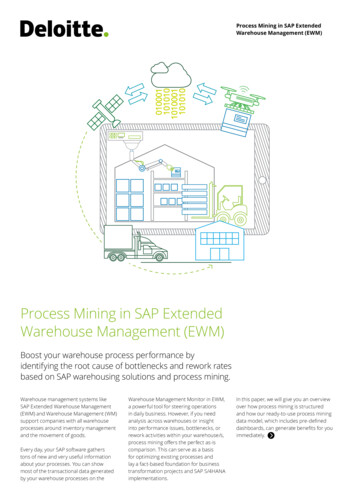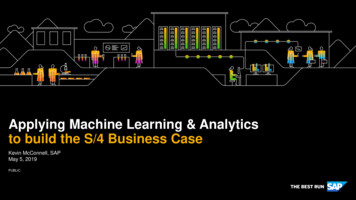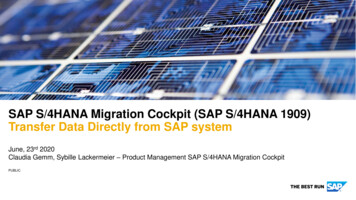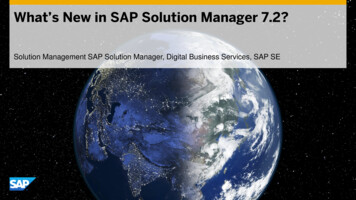
Transcription
Process Mining in SAP ExtendedWarehouse Management (EWM)Process Mining in SAP ExtendedWarehouse Management (EWM)Boost your warehouse process performance byidentifying the root cause of bottlenecks and rework ratesbased on SAP warehousing solutions and process mining.Warehouse management systems likeSAP Extended Warehouse Management(EWM) and Warehouse Management (WM)support companies with all warehouseprocesses around inventory managementand the movement of goods.Every day, your SAP software gatherstons of new and very useful informationabout your processes. You can showmost of the transactional data generatedby your warehouse processes on theWarehouse Management Monitor in EWM,a powerful tool for steering operationsin daily business. However, if you needanalysis across warehouses or insightinto performance issues, bottlenecks, orrework activities within your warehouse/s,process mining offers the perfect as-iscomparison. This can serve as a basisfor optimizing existing processes andlay a fact-based foundation for businesstransformation projects and SAP S/4HANAimplementations.In this paper, we will give you an overviewover how process mining is structuredand how our ready-to-use process miningdata model, which includes pre-defineddashboards, can generate benefits for youimmediately.
Process Mining in SAP Extended Warehouse Management (EWM)“Process mining provides a real-timeinsight into warehouse activities andhow these are influenced by reworkactivities and process bottleneckssuch as repacking activities, pickingchanges, and door occupation.”Warehouse managementThe primary function of a warehouseis stock management. In any business,the stock overview helps to analyze andkeep track of demand and supply. Awarehouse management system (WMS)therefore supports resource planning andefficient material requirement planningfor both simple and complex processes.To deal with the challenges presentedby these processes, along with processdigitalization and a better overview ofwarehouse activities, SAP launched SAPERP Warehouse Management (WM) in1993. SAP then developed and releaseda new WMS in 2005, SAP ExtendedWarehouse Management (EWM), toprovide more flexibility within warehousestructures and processes and to managemore complex warehouses, e.g. those withautomated material handling equipment.SAP’s EWM is currently one of the marketleaders in warehouse managementsoftware, according to Gartner’s 2020Magic Quadrant1. With the launch of SAPS/4HANA, SAP has also announced thatsupport for SAP EWM’s predecessor,1202SAP WM, will end in 20272. This providesexisting SAP WM and new SAP customerswith a strong incentive to deploy SAP EWMas their one and only WMS in the comingyears. SAP EWM has the ability to run bothembedded in SAP S/4HANA and as a standalone instance, providing more flexibility toits customers.The digitalization of all business processes,including those around warehouses, andthe general trend towards Industry 4.0, hasgiven companies an enormous database ofvaluable information with which to analyzeprocesses and businesses. SAP offers awide range of tools for this as standard.Nevertheless, in the area of warehousemanagement, their focus is primarilyon daily order handling and warehouseprocesses. Actual process flows arenot included, nor how these differ fromexpected or designed processes. In timeswhen logistics constitute an essentialpart of the business, costs can be savedby avoiding rework and making logisticsexecution processes more efficient.Fig. 1 – Business benefitsTransparency aboutwarehouse processesand their flowsReduce rework activitiesup to 30% and avoidlosing time and moneyCross-warehouse processanalysis, increaseproductivity up to 10%Identify internal bestpractice based onbenchmarkingAnalyze bottleneckswithin your warehouse K lappich, C., & Tunstall, S. (2020). Magic Quadrant for Warehouse Management Systems. Gartner Inc. SAP Support, „Extended Innovation Commitment for SAP S/4HANA“ (2020) 4hana-business-suite7.html
Process Mining in SAP Extended Warehouse Management (EWM)Process MiningThe ever-growing complexity of businessoperations poses tremendous challengesfor process transparency. Anxious for acompetitive edge in the digital age, manycompanies conduct process optimizationand transformation without even havinga clear picture of the current state. Thisoften leads to the wrong strategies andhigh costs of failure. Process mining isa new analytics discipline that uses thedigital footprints of IT systems (e.g. activitytimestamps) to reconstruct end-to-endbusiness processes.The Deloitte Center for Process Bionicsuses process mining technologies tohelp clients create full transparency oftheir business processes. This includesprocess visualizations, conformity checks,and root-cause analyses. Furthermore,transactional data and master data isbrought together with process data tocreate a 360-degree view for monitoringbusiness operations from every angle.This enables the identification of potentialproblems before they cause damage andincreases productivity by up to 10 percent,ultimately establishing a higher level ofprocess excellence.Extracting process dataProcess reconstruction is based on threekey data components: Case identifiers Events TimestampsThe case identifier represents a singleinstance of a process, which could be thesales order number that is the basis for anSAP EWM outbound process, for example.The identifier connects all relevantactivities as well as master data to theprocess. Every case consists of a number ofevents that show what is happening withinthe process. These events can be readfrom the log files of IT systems like SAPEWM, where all case-related activities aresaved, and used to recreate the process ona very detailed level. Examples of activitiesin the outbound process are “OutboundDelivery Created” or “Loading Started”.The final component that is necessaryfor process mining is timestamps of theevents. They place process events in thecorrect order and allow an analysis ofthroughput time between certain activities.With this information, process bottleneckswhich are a major root cause of inefficiency,can be identified easily.To establish process mining, it is necessaryto have these process traces in the formof data in your systems. The first step inany process mining project is therefore toidentify all relevant data records from oneor more source systems. In the secondstep, these are transferred from the sourcesystems to an analysis environment, suchas a data warehouse or data lake.Once all raw data is available for analysis,project cases and events can be extractedinto the new process mining data model.This is done by querying event-relatedtables for timestamps that are connectedto the case identifier. For example, theevent “Outbound Delivery Order QuantityChanged” can be retrieved from thechangelog by querying records where thecorresponding field in the order item tablehas changed. The timestamp of the changeactivity is then used as the timestampfor the process event. Furthermore, BI(Business Intelligence) tables are integratedinto the data model as well; these consistof master data and transactions and aremapped to process instances. This allowsanalysis of the process in all its relateddimensions and Key Process Indicators(KPIs), such as packaging material or ordervolume. This end-to-end data processingpipeline is managed by the Deloitte ProcessMining Framework.The resulting process data model can beintegrated into a large number of processmining applications to visualize the process.Use cases range from the usual savings ofworking materials and time, to reductionsin wait times, waste and rework, a decreasein tied-up capital, the identification andprevention of compliance violations,the harmonization and simplification ofprocess flows, and continuous reporting ofprocesses. A distinction is typically madebetween explorative and hypothesis-basedanalysis dashboards.“The Deloitte Center for Process Bionicsuses process mining technologies tohelp clients create full transparency oftheir business processes.”03
Process Mining in SAP Extended Warehouse Management (EWM)Fig. 2 – Process mining pipelineExtraction of process-relevant data Timestamp Activity ID of the transaction Relevant meta dataData processing Using the Deloitte Process Mining Data FrameworkProcess visualization Process flow per transaction KPIs including lead time according to different dimensions (e.g. customers)Standard Process MiningDigital DiscoveryOur service offeringThe transactional data in SAP EWM isused for monitoring and analyzing historicand ongoing warehouse activities. Ittherefore represents a valuable basis fordecision-making in day-to-day warehousingoperations. Nevertheless, some valuableinsights regarding performance issues,bottlenecks, and rework activitiesare not directly visible in the system.It is possible, with some add-ons, tointroduce new monitoring ‘nodes’ forlooking at existing data from new pointsof view. Unfortunately, this can be atime-consuming and frustrating RFC (SAPinterface for communication) processfor the business. This is why the idea ofapplying process mining based on SAPS/4HANA and SAP EWM transactional datawas born.Data ProcessingBased on SAP transactional data, wehave generated data models for the threecore processes of SAP EWM: inbound,outbound, and internal productionprocesses. These predefined data modelsserve as foundation for client-specificprojects and provide immediate benefits.Transactional data originating from SAP04modules as well as non-SAP systemscan easily be integrated in existing datamodels. Examples of other data sourcesinclude transportation management, yardmanagement and production planning andexecution software.Implementing cross-system processmodels and feeding them from severalsources requires global keys that linkdifferent systems; this prevents overlapsand associated conflicts during processingand subsequent analysis. We use theDeloitte Process Mining framework tomeet this challenge. This platform providesmany mechanisms in a modular design tomanage and structure process-related dataacross system boundaries. As an integralcomponent, it successively establishes anaming structure that spans all processesand systems, so that new process miningmodels can be integrated faster and withgreater stability.For SAP EWM, our team of experts hasalready realized the foundation for an easilyimplemented service. It uses warehouseprocess-related building blocks based onthe most common SAP LE and SAP EWMactivities and uses these to immediatelygenerate added value for our clients. Theextent of the enhancements is based onthe system set-up and any deviations fromstandard fields and tables.Event dataAs explained in the process mining section,events are used to track the activities ofa business object in the system as theyhappen at a certain point in time. For thispurpose, we extract a combination of caseidentifiers, warehouse-related events, andtimestamps from the source system tobuild up process flows and provide insightsinto the duration, sequence, and regularityof these activities.To speed up future implementationprocesses, we predefined a large numberof events for different warehouseprocesses, based on SAP standard andbest practice processes from severalindustries. In cooperation with clients, wecan include additional events and metadatathat describes the entities belonging to theprocess in detail. It is also possible to takecustomer specific (Z-) tables and fields intoaccount.
Process Mining in SAP Extended Warehouse Management (EWM)Process visualizationThe event data gathered from the systemis combined with metadata from orderdocuments and displayed in customizabledashboards. We are then able to monitorend-to-end-processes, identify criticaldeviations, and tackle future risks in logisticsprocesses. Each dashboard focusses on aspecific KPI and has its own focus, which canbe further narrowed down with selectioncriteria such as time windows, warehousenumbers, or material groups.“We are able to monitor end-toend-processes, identify criticaldeviations, and tackle future risksin logistics processes.”Understanding processesThe process overview (see figure 3) helpsanalyze processes and gain insight intorework activities such as repacking, as wellas other deviating process sequences ininbound or outbound processes. In thecase of SAP EWM, it is particularly beneficialto analyze process flows from multipleorders over a certain period in time in oneoverview. This helps identify irregularitiesand deviations from the expected processsequence.Fig. 3 – Process overview dashboardIdentifying internal best practicesThe benchmarking dashboard (seefigure 4) provides detailed insights intoall processes and variants with extensivecustomization options for benchmarkingcomparisons. It allows users to compareprocess performance and throughputtime, e.g. broken down by customer,material number, or carrier on a crosswarehouse basis.Fig. 4 – Benchmarking dashboard05
Process Mining in SAP Extended Warehouse Management (EWM)Avoiding reworkThe rework dashboard (see figure 5)analyzes processes and supportswarehouses with insight into the rateof activity occurrence or rework, e.g. inpicking, packing, and staging activities.Different selection criteria allow users tofocus on specific tasks or task sequences.Every time a warehouse activity isrepeated, it costs time and thereforemoney; identifying avoidable rework thusunlocks cost saving opportunities.Fig. 5 – Rework dashboardAnalyzing bottlenecksThe bottleneck dashboard (see figure 6)allows users to explore areas where workis delayed and identify the causes ofbottlenecks. The aim of this dashboardis to get work flowing through everyworkstation at a steadier pace. Forexample, if some trucks occupy loadingdocks for longer than expected, thisinformation can be cross-referenced withavailable metadata to identify correlationswith certain carriers or material groups.Fig. 6 – Bottleneck dashboard06
Process Mining in SAP Extended Warehouse Management (EWM)InfrastructureAs an alternative to installing the readymade process mining solution on-premise,you can benefit from process mining asa Service (PMaaS). The Deloitte ProcessBionics Platform is a fully managed cloudsolution for process mining that givesaccess from a worldwide repository ofproven process mining dashboards anddata models, as well as different processmining software solutions. As a fullymanaged service, the Process Bionicsplatform allows you to focus on creatingvalue rather than on technical details. Itis instantly available for use, and due toits flexible and scalable cloud approach,it fits perfectly for your organization’sneeds. It can also be adapted along yourprocess mining journey. By only payingfor the components you actually use, thetransparent licensing model gives you fullcontrol over costs.Process ExcellenceUsing data- and fact-based insights fromtop-down and bottom-up perspectiveson your SAP EWM processes, we can helpyou define the right process optimizationmeasures to tackle process bottlenecksor support your digitalization strategy.Together with our business and industryexperts, we help you realize the impactin terms of operational efficiency, costsavings and compliance.Our agile service offering provides youwith an easy start on your processexcellence journey, step by step: Proof of Valueprovides a thorough understandingof the vast potential of process miningbased on your own data. Quick prototyping of one process by leveraging standardized building blocks and hands-onworkshops with our process miningand logistics process experts offerfirst insights into hidden optimizationpotentials. Process Diagnosticsyields highly quantified and actionableimprovement measures targeted atsubstantial impact and a rapid return.This is achieved with deep-dive analyticson processes and associated behaviorsacross system boundaries. Combinedwith our lean and industry expertise, wecreate best-in-class process landscapes. Continuous Evolutionembeds process mining into the DNA ofyour organization to ensure holistic andcontinuous process optimization. Theintegration of process mining analysisblueprints into the corporate core anda dedicated governance structure forprocess excellence preserve competitiveadvantages. A comprehensive trainingstrategy for key practitioners and leanexperts results in sustainable impact.Alongside implementing optimizationmeasures, we train your functionalteams to use the process analyses andcontrol dashboards to track your processoptimization results. In that way, we helpyour organization to continuously challengeand improve daily business operations.“Our team of experienced data scientists,SAP logistics execution experts, andbusiness process consultants willseamlessly implement the processmining tools for analyzing processes inSAP warehousing solutions.”07ConclusionProcess mining is a state-of-the-artanalytical discipline that uses processdata from IT systems to reconstruct actualprocesses on a transactional level. It offersthe perfect as-is comparison to serve asa basis for optimizing existing processesand lays a fact-based foundation forbusiness transformation projects andSAP S/4HANA implementations. Processmining offers companies full transparencyof their SAP logistics execution processes,generating knowledge that feeds intowarehouse process optimization measuresand is the starting point for continuousoperational excellence.It provides a real-time insight into thewarehouse activities and how these areinfluenced by rework activities and processbottlenecks such as repacking activities,picking changes and door occupation. Byidentifying bottlenecks and rework, usersare able to eliminate risks and unnecessarycosts, thereby improving their processesand making them more efficient.Our team of experienced data scientists,SAP logistics execution experts, andbusiness process consultants willseamlessly implement the process miningtools for analyzing processes in SAPwarehousing solutions. The ready-to-useprocess mining data model includes predefined dashboards and is the foundationfor kick-starting implementation projectsand immediately generating benefits foryou as our client.We want to help you boost your warehouseprocess performance by identifying theroot cause of bottlenecks and rework ratesbased on SAP warehousing solutions andprocess mining. Please feel free to contactour team if you have any questions or areinterested in a showcase of our serviceoffering for your company.
Process Mining in SAP Extended Warehouse Management (EWM)ContactOlly SalzmannPartnerLead Artificial IntelligenceTel: 49 (0)211 8772 2082osalzmann@deloitte.deStephan BodePartnerSAP Offering leadTel: 49 (0)151 5807 0100stbode@deloitte.deFrank FranzlikDirectorCenter for Process BionicsTel: 49 (0)89 29036 6025ffranzlik@deloitte.deTheophilos KotzaerogluDirectorSAP Supply Chain TransformationTel: 49 (0)151 58072314tkotzaeroglu@deloitte.deDavid RicoManagerSAP Supply Chain ExecutionTel: 49 (0)151 58001563darico@deloitte.deSander GroenenSpecialist ManagerSAP Supply Chain ExecutionTel: 49 (0)89 29036 7515algroenen@deloitte.deDominik LehmannSenior ConsultantCenter for Process BionicsTel: 49 (0)89 29036 6706dolehmann@deloitte.deYingtao GuSenior ConsultantCenter for Process BionicsTel: 49 (0)89 29036 6082yingu@deloitte.deAnnette DekkerConsultantSAP Supply Chain ExecutionTel: 49(0)89 29036 8041adekker@deloitte.de
Process Mining in SAP Extended Warehouse Management (EWM)This communication contains general information only not suitable for addressing the particularcircumstances of any individual case and is not intended to be used as a basis for commercial decisionsor decisions of any other kind. None of Deloitte GmbH Wirtschaftsprüfungsgesellschaft or Deloitte ToucheTohmatsu Limited, its member firms, or their related entities (collectively, the “Deloitte network”) is, by meansof this communication, rendering professional advice or services. No entity in the Deloitte network shall beresponsible for any loss whatsoever sustained by any person who relies on this communication.Deloitte refers to one or more of Deloitte Touche Tohmatsu Limited, a UK private company limited byguarantee (“DTTL”), its network of member firms, and their related entities. DTTL and each of its member firmsare legally separate and independent entities. DTTL (also referred to as “Deloitte Global”) does not provideservices to clients. Please see www.deloitte.com/de/UeberUns for a more detailed description of DTTL and itsmember firms.Deloitte provides audit, risk advisory, tax, financial advisory and consulting services to public and private clientsspanning multiple industries; legal advisory services in Germany are provided by Deloitte Legal. With a globallyconnected network of member firms in more than 150 countries, Deloitte brings world-class capabilitiesand high-quality service to clients, delivering the insights they need to address their most complex businesschallenges. Deloitte’s approximately 312,000 professionals are committed to making an impact that matters.Issue 10/2020
warehouse activities, SAP launched SAP ERP Warehouse Management (WM) in 1993. SAP then developed and released a new WMS in 2005, SAP Extended Warehouse Management (EWM), to provide more flexibility within warehouse structures and processes and to manage more complex warehouses, e.g. those with automated material handling equipment.











